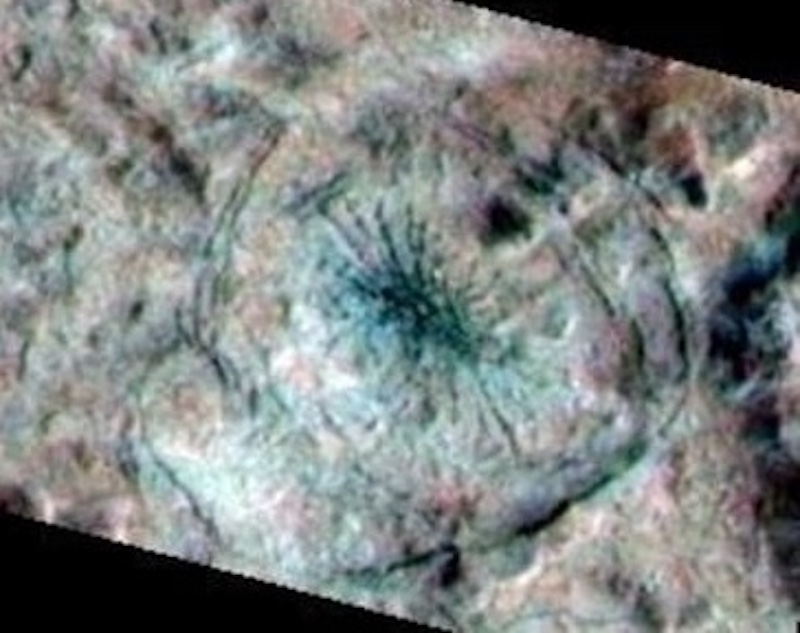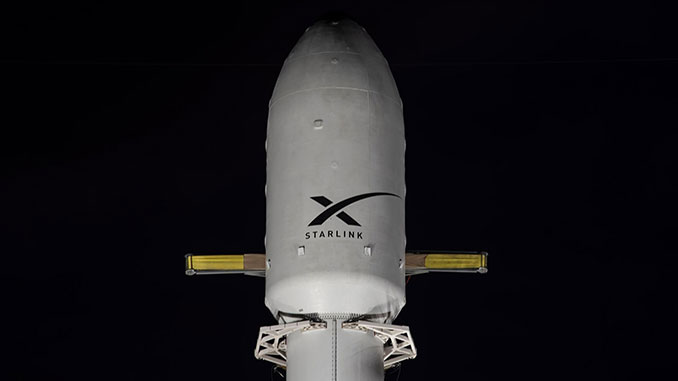Now Reading: When will the Blaze Star explode and how can I see it?
-
01
When will the Blaze Star explode and how can I see it?
When will the Blaze Star explode and how can I see it?
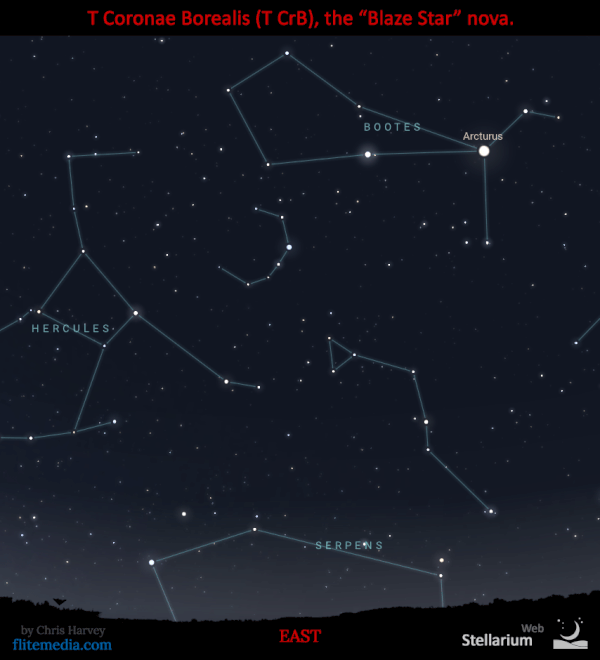

Waiting for the Blaze Star to go nova
Have you ever heard of the Blaze Star? It’s a star in the constellation Corona Borealis the Northern Crown that was supposed to go nova last year. Well, we’re still waiting. But when it finally does erupt, it’ll be a once-in-a-lifetime show in our night sky.
The eagerly awaited Blaze Star nova is a real opportunity for keen night sky observers to witness a “new star” in the sky … but only for a few days before it fades away again. Here’s more about why we’re still waiting on the Blaze Star. And about how you can see when it does finally erupt as a nova.
You’ll want to look east as the sky gets dark. It helps to observe from a dark-sky location. Look between the handle of the Big Dipper and the horizon to see the backward C shape that marks Corona Borealis. More on how to see it below.
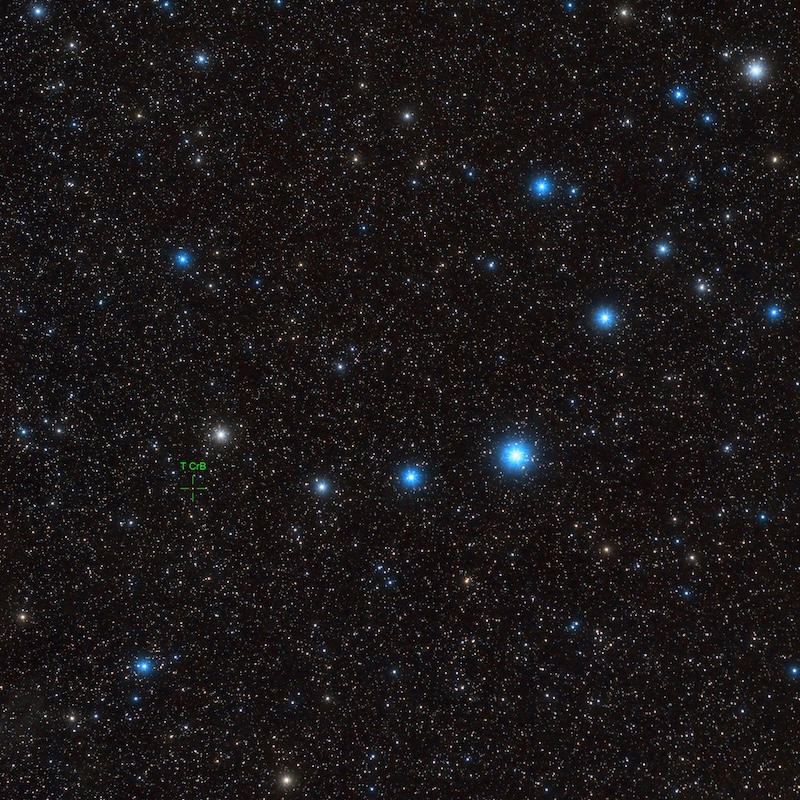
Many predictions for the Blaze Star’s eruption
At first the predictions for the Blaze Star’s eruption focused on last year from about April to October. Then Jean Schneider of the Paris Observatory published some new predictions in the Research Notes of the American Astronomical Society in October 2024. He pinpointed possible dates of March 27, 2025, and November 10, 2025. The first date has come and go with no big kablooey.
Schneider came to his possible dates using a combination of the previous eruption dates and the orbital ephemeris of the binary system. While Schneider admits in his paper that no one can exactly predict the eruption, he is trying to predict eruption dates with a precision of a week or two. Will his November prediction hold up? The only way to know for sure is to wait and see.
Why hasn’t it happened yet?
Predicting eruptions of stars is not an exact science. The Blaze Star (T Coronae Borealis) underwent two known eruptions recorded by astronomers. Those events were on May 12, 1866, and on February 9, 1946. Those eruptions were 80 years apart. So scientists thought that, in another 80 years, the star would erupt again. So, 80 years from 1946 would be 2026. Which raises the question: Why did astronomers think the eruption would happen in 2024?
Well, the star brightened and dimmed before its last eruption in 1946. And it has been brightening and dimming now as well, leading some to think the nova would happen sooner rather than later. But it appears as if later is more likely. And so we wait …
In the meantime, here’s how to find Corona Borealis and be ready to see it when the nova arrives.
Why will it go nova
The Blaze Star isn’t one star but two. It’s a binary system with a white dwarf and a red giant. White dwarfs are stellar remnants, the exposed core of a sunlike star that shed its outer layers at the end of its main-sequence life. It’s a super-dense star with the mass of our sun but only the size of Earth.
Blaze Star’s white dwarf has built up material on its surface, siphoned off from the red giant star. Periodically, it “can’t take no more” and explodes, about every 80 years.
This is our best opportunity to see a nova with some warning. Plus we have great visual context from the surrounding C-shape of stars. So cross your fingers for good weather when it happens.
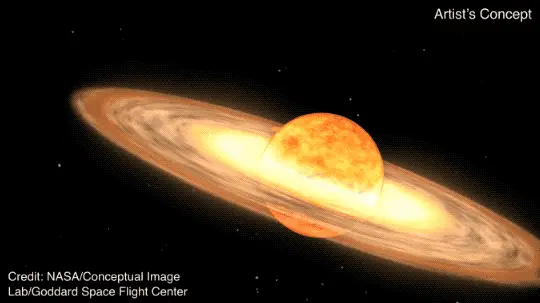
Where to look to find the Blaze Star
The constellation Corona Borealis rotates around Polaris just outside of what we traditionally think of as the circumpolar constellations. This mean it’s not visible all year round for much of the Northern Hemisphere.
The easy-to-find constellation looks distinctly like a backward C at this time of year. It lies between the bright star Arcturus and the squarish four-star shape of Hercules. Look east after dark to find the constellation rising. If you can spot the Big Dipper, look between it and the horizon to find a faint backward C shape. That’s Corona Borealis.
By the summer these constellations will be high in the sky again. You always need to spend some time dark-adapting your eyes before you see the constellations properly. Plus, binoculars would be a good idea. And you need to be ready to go when we get the news, as it will only be there for a couple of days.

How bright will the Blaze Star be?
The actual explosion of the Blaze Star nova will likely dwarf any explosion you’ll ever see. But the star is far away. How bright will it get in our sky? Astronomers expect it to reach an apparent magnitude of 2. That’s a respectable brightness for a star. It’s conveniently comparable to the brightest star in the Northern Crown, the Jewel of the Crown, Alphecca. So, for a few days, the Northern Crown will have two jewels!
T Corana Borealis – the Blaze Star – also one of the most distant stars you’ll ever see. Alphecca is around 75 light-years away, while the Blaze Star is closer to 3,000 light-years away. So that gives you some perspective on the absolute magnitude (brightness) of this enormous blast. And since the light of this explosion has travelled for 3,000 years to get here, in relative terms the nova happened during the Bronze Age.
Remember that, when they are side-by-side with approximately the same brightness, the nova is 40 times farther away than Alphecca. Also, we are not seeing the two stars at the same moment in time. One we see as it was 75 years ago and the other we see as it was 3,000 years ago. It can be hard to get your head around that!
The nova will brighten the star by thousands of times, typically over just a few hours, and then take some days to fade away again. When it’s done, it will go back to its normal appearance.
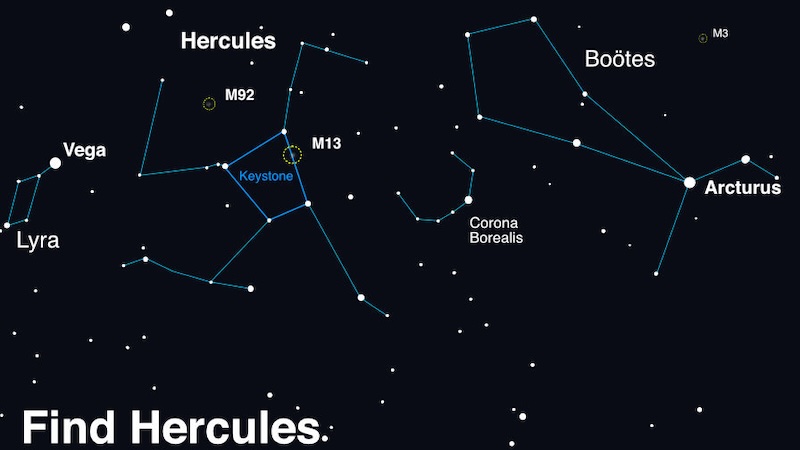
Finding Corona Borealis, the Northern Crown
If you are not familiar with the Northern Crown, get out and have a look at it before this nova happens. And then, clouds willing, when it does erupt we can go out and see the C shape is harder to spot. Instead, the dominant feature will be two bright-ish stars, Alphecca (the brightest star in Corona Borealis) and the Blaze Star.
The Blaze Star is normally invisible to the unaided eye. On a regular day, it sits at around magnitude 10, making it only the 19th brightest star in the constellation. But as it undergoes a colossal outburst of energy, it will brighten.
Bottom line: We’re still waiting for the Blaze Star to go nova! Here’s how to find Corona Borealis so you’re ready when it does happen.
Source: When will the Next T CrB Eruption Occur?
The post When will the Blaze Star explode and how can I see it? first appeared on EarthSky.
Stay Informed With the Latest & Most Important News
Previous Post
Next Post
-
 01From Polymerization-Enabled Folding and Assembly to Chemical Evolution: Key Processes for Emergence of Functional Polymers in the Origin of Life
01From Polymerization-Enabled Folding and Assembly to Chemical Evolution: Key Processes for Emergence of Functional Polymers in the Origin of Life -
 02Panasonic Leica Summilux DG 15mm f/1.7 ASPH review
02Panasonic Leica Summilux DG 15mm f/1.7 ASPH review -
 03Two Black Holes Observed Circling Each Other for the First Time
03Two Black Holes Observed Circling Each Other for the First Time -
 04How New NASA, India Earth Satellite NISAR Will See Earth
04How New NASA, India Earth Satellite NISAR Will See Earth -
 05And Thus Begins A New Year For Life On Earth
05And Thus Begins A New Year For Life On Earth -
 06Astronomy Activation Ambassadors: A New Era
06Astronomy Activation Ambassadors: A New Era -
07SpaceX launch surge helps set new global launch record in 2024














